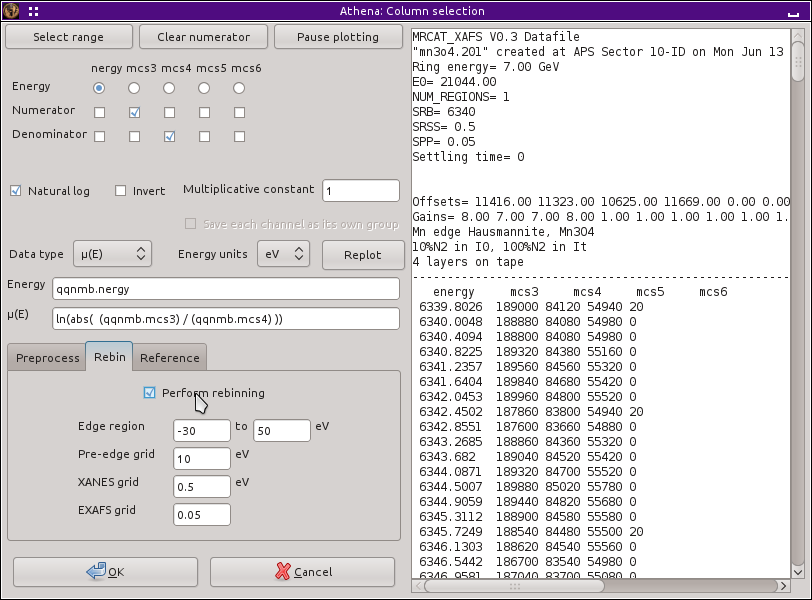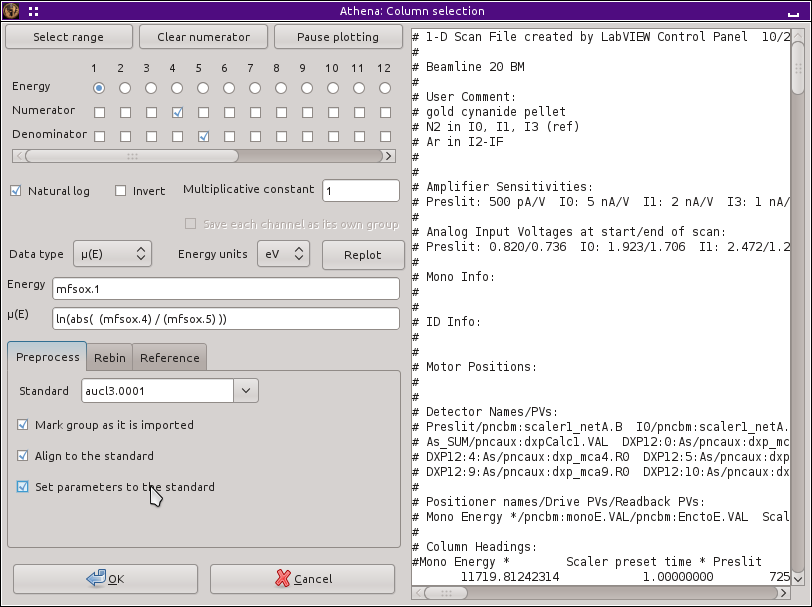3.5. Preprocessing data¶
There are a number of other operations that ATHENA can perform on your data as it is imported. These are found in the other tabs on the bottom left of the column selection dialog. Note that all of the pre-processing chores discussed here can also be performed on data after it has been imported. See the data processing chapter. for more details.
3.5.1. Rebinning quick scan data¶
Some beamlines offer the option of collecting data as a quick scan. In that scanning mode, the monochromator is slewed continuous from the beginning of the scan to the end. The detectors are read continuously and integrations of the detector signals are stored in intervals. The length of these intervals and the slewing speed of the monochromator determine the energy width of each measurement bin. Typically these measurement parameters are chosen to provide adequate resolution through the edge – typically a third or a half of an electron volt. This results in data that are vastly over-sampled in the EXAFS region. To improve the statistics in the EXAFS region and to make the data arrays smaller, it is useful to rebin the data. This process uses a boxcar averaging to place the evenly spaced quick scan data onto a typical EXAFS grid. That grid is usually something like 10 eV in the pre-edge, 0.5 eV through the edge, and 0.05 Å -1 in the EXAFS region.
In this screenshot, I have imported some data on a uranyl compound measured in quick scan mode:
At this stage, ATHENA has not examined the data closely enough to have guessed what edge you are measuring, so you must specify the element symbol of the absorbing atom. The remaining numeric parameters define the grid onto which these data will be rebinned. The first two numbers define the boundaries of the edge region in energy, the third defines the size of the grid in the pre-edge, the fourth defines the size of the grid through the edge, and the last defines the grid in wavenumber in the EXAFS region.
ATHENA will remember the values of these parameters between data sets. However, the default is to turn off rebinning for each new data set. Therefore you must click to the rebinning tab for every data set you import, and click on the Perform rebinning check button. When you import multiple data sets, though, rebinning will be performed on each one without intervention according to the normal rules of multiple data set import.
3.5.2. Other pre-processing chores¶
 This tab provides controls for a number of other
things that can be done with your data as it is imported. The first
one – marking – can be performed even on the first data set
imported. The other two require that a standard be specified. The menu
at the top of the tab contains every item from the group list. The one
specified in that menu is the standard.
This tab provides controls for a number of other
things that can be done with your data as it is imported. The first
one – marking – can be performed even on the first data set
imported. The other two require that a standard be specified. The menu
at the top of the tab contains every item from the group list. The one
specified in that menu is the standard.
Here are descriptions of each of the pre-processing chores, seen in the image above:
- Mark each data set
- If this is selected, each data set will be marked as it is imported. Note that the reference spectrum is not marked. Also note that, unlike the other four pre-processing options, this one is always deselected when new data is imported.
- Align to the standard
- If this is selected, the data are aligned to the specified standard using the auto-alignment algorithm. If both the data and standard have reference channels, those are used in the auto-alignment.
- Set parameters to the standard
- If this is selected, all parameters (except for «eshift») will be set to the values of the standard.
The pre-processing tab is one of ATHENA's genuine power features. With a bit of forethought, most of your data processing can be performed automatically. I typically import one data file and carefully calibrate it and set its various parameters. Having done that, the remaining data gets well processed simply by reading it in. This kind of time saver is of particular value at the beam line.
DEMETER is copyright © 2009-2016 Bruce Ravel – This document is copyright © 2016 Bruce Ravel
This document is licensed under The Creative Commons Attribution-ShareAlike License.
If DEMETER and this document are useful to you, please consider supporting The Creative Commons.


